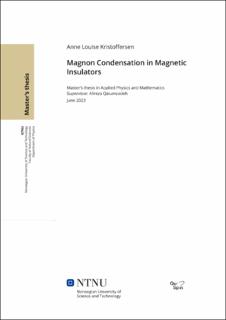| dc.contributor.advisor | Qaiumzadeh, Alireza | |
| dc.contributor.author | Kristoffersen, Anne Louise | |
| dc.date.accessioned | 2023-10-14T17:20:35Z | |
| dc.date.available | 2023-10-14T17:20:35Z | |
| dc.date.issued | 2023 | |
| dc.identifier | no.ntnu:inspera:136730593:33625479 | |
| dc.identifier.uri | https://hdl.handle.net/11250/3096571 | |
| dc.description.abstract | Bose-Einstein kondensasjon er et forskningsfelt som har fått økt oppmerksomhet etter at Ketterle et al. og Cornell et al., i 1995, fremstilte et kondensat for første gang. Begge gruppene laget kondensatet av reelle materialpartikler, nærmere bestemt svakt vekselvirkende atomgasser. Magnoner er bosoniske eksitasjoner av et magnetisk ordnet system. De ble foreslått for første gang av Felix Bloch i 1936. I 2006 fremstilte Demokritov et al. de første kondensatene av magnoner ved romtemperatur.
Magnetisk dipolvekselvirkning er svært viktig ved fremstilling av et kondensat av magnoner, selv om den er svak. For å kunne ha et stabilt kondensat, må potenisalet mellom bestanddelene være frastøtende. Den sterkere Heisenberg vekselvirkningen og Zeemankoblingen vil ikke gi potenisalet de nødvendige egenskapene. Spesialiserings\-prosjektet analyserer stabliteten til et kondensat av magnoner i ferromagnetiske isolatorer, spesifikt for en tynn film av yttrium-jern granat. Vi har fulgt arbeidet til Kopietz , Li og Demokritov i denne fullstendige analysen av stabiliteten. Vi fant et ledd i vekselvirkningspotensialet som ikke var beskrevet i litteraturen.
Endelige bevis for Bose-Einstein kondensasjon av magnoner i antiferromagnetiske isolatorer er ennå ikke funnet. Vi utfører analyser for et antiferromagnetisk system, analogt med analysene som allerede er utført for ferromagnetiske systemer. Vi har funnet kombinasjoner av parametere for systemet som underbygger teorien om at det er mulig for magnoner, med impuls forskjellig fra null, å kondensere i antiferromagnetiske isolatorer. Vi fant også at med disse parameterne vil mellomdals-spredning, altså spredning mellom de to typene antiferromagnetiske magnoner, dominere vekselvirkningspotensialet. Vi tror dette kan være nyttig for å bestemme parametere for eksperimenter i antiferromagnetiske systemer, hvor man ønsker å finne kondensasjon av magnoner. | |
| dc.description.abstract | Bose-Einstein condensation as a theoretical concept was suggested a century ago, but is a relatively new research field experimentally. It gained attention after Ketterle et al.
and Cornell et al. realised the first condensates in 1995. The condensates were formed of weakly interacting, real atomic gases. Magnons, which are quasiparticle
bosonic excitations of a magnetically ordered system, were proposed by Felix Bloch in 1936. In 2006 Demokritov et al. found evidence of Bose-Einstein condensation of magnons at room temperature for the first time.
To explain the physics leading to a magnon condensate in ferromagnetic insulators, the dipolar interaction between the spins is essential, although it is weak. To realise a BEC, there needs to be a repulsive effective interaction between the magnons, which the direct exchange interaction and Zeeman coupling are unable to provide on their own. Part II of this work will revisit the calculations leading to the prediction of Bose-Einstein condensation of magnons in yttrium-iron garnet. To obtain this complete analysis of the stability, we have closely followed the work done by Kopietz, Li and Demokritov. We find a term in the interaction potential that was missing in the literature.
Conclusive evidence of Bose-Einstein condensation of magnons in antiferromagnetic insulators has not yet been found. We perform similar calculations as for the ferromagnetic system, to predict the theoretical existence of such condensates. We found that there are combinations of parameters for the system that facilitates condensation of magnons in antiferromagnetic insulators at non-zero momenta. When the interactions between the magnons in the condensates are repulsive, we found that the intervalley scattering, namely between the two types of magnons, dominates the interaction potential. We believe that our analysis can be of use for determining parameters in future experiments, where the goal is to observe condensation of magnons. | |
| dc.language | eng | |
| dc.publisher | NTNU | |
| dc.title | Magnon Condensation of Magnetic Insulators | |
| dc.type | Master thesis | |
